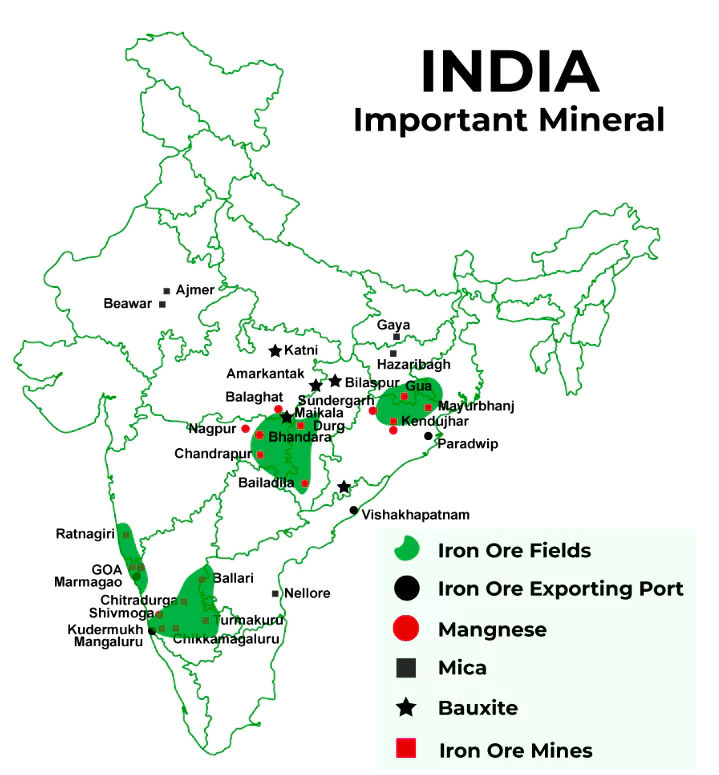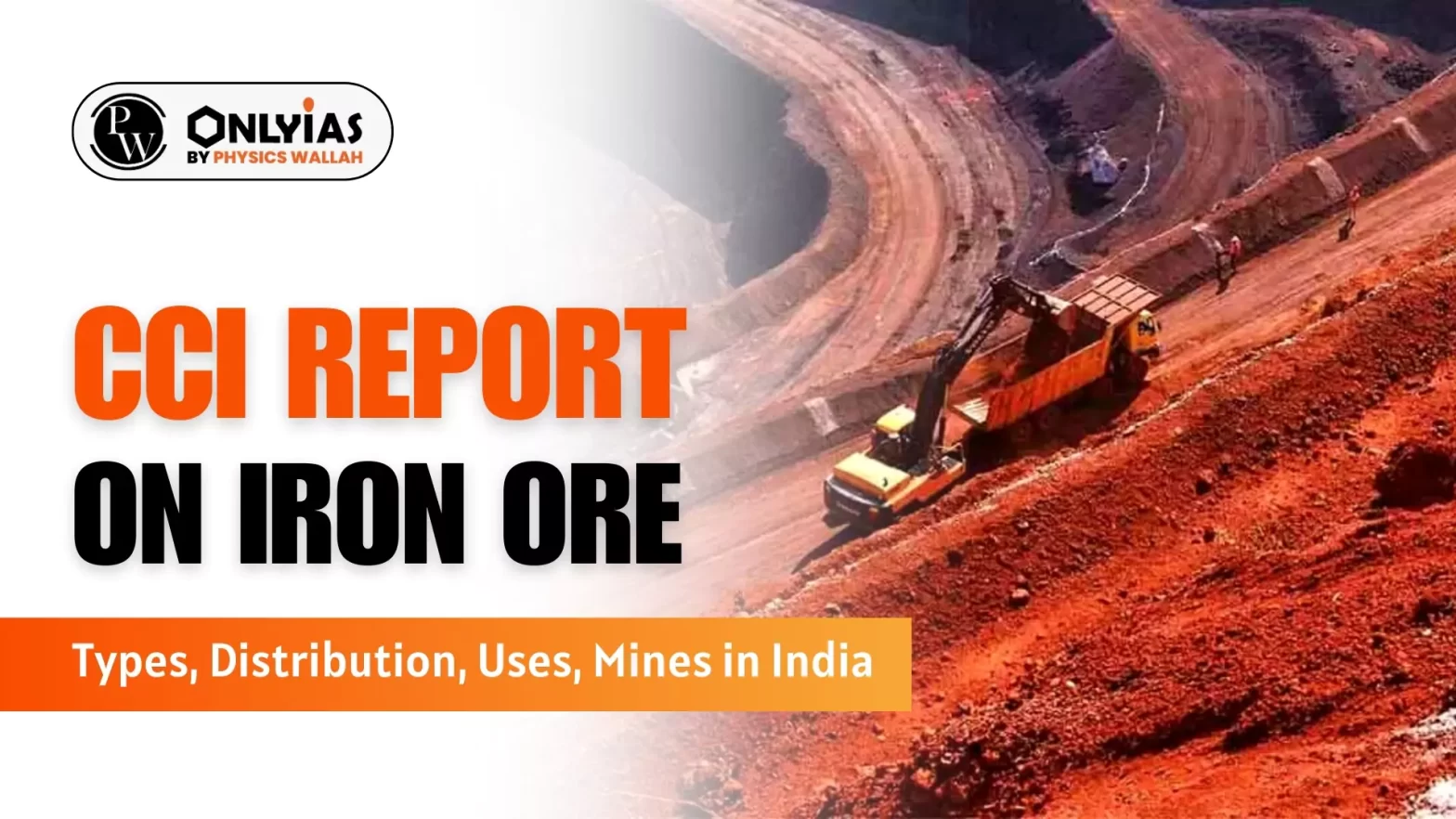Context:
This article is based on the news “Iron ore faces challenges of sustainability and fairness” which was published in the Live Mint. The Competition Commission of India (CCI) along with the Institute for Studies in Industrial Development has recently published a market study report on India’s iron ore sector.
India’s Iron Ore Industry and Its 2.3% GDP Contribution
- Minerals Auction Target: The report coincides with the government’s recent announcement, setting a target to put 500 blocks of minerals on auction by 2025-26 which will include rare earth elements (REEs) and precious metals.
- Iron Mining in India: India produces 87 types of metallic and non-metallic minerals and mining activity accounts for roughly 2.3 percent of India’s GDP in 2022-23.
- Iron Ore Mines in India: There are 1319 reporting mines. Of these, 97 percent mines are located in seven states, namely Odisha, Chhattisgarh, Rajasthan, Karnataka, Jharkhand, Madhya Pradesh and Maharashtra.
Enroll now for UPSC Online Course
About Competition Commission of India (CCI)
- It is a statutory body of the Government of India, was established in March 2009 under the Competition Act, 2002.
- Goal: To create and sustain fair competition in the economy that will provide a ‘level playing field’ to the producers and make the markets work for the welfare of consumers.
- Headquarters: New Delhi.
|
Types of Iron Ore
Based on the amount of ore and iron content, iron ore is classified into various types:
- Magnetite (FE3O4): It is a good quality ore and has very high iron content (about 70%). Black in colour and has magnetic properties.
- Haematite (FE2O3): Reddish ore with 60-70% iron.
- Limonite: Yellowish ore with 40% to 60% iron.
- Siderite: Ore with less than 40% iron. It contains many impurities and hence mining, in many places, is economically unviable.
Uses of Iron Ore
- Its most common uses are for making steel and iron products such as nails, tools, and pipes.
- It plays a vital role in creating machine parts for the automotive, aerospace, and other industries.
|
Iron Ore Sector in India
- The Backbone of Industrial Development in India: Iron ore is the basic mineral and the backbone of industrial development. The total reserves of iron ore in the country were about 22,487 million tonnes in the year 2015.
- Primary Ore Varieties in India: The two main types of ore found in our country are haematite and magnetite. India’s iron ores are mostly Hematite and India is the 2nd largest producer of hematite after Russia.
- Iron Ore Production in India: India is self-sufficient in iron ore production, and contributes 7 percent of the global production and India is the fourth largest producer of iron ore in the world after Australia, Brazil, and China.
- Iron ore holds a dominant position, accounting for 79 percent of the total mineral value produced in the country.
- State’s Share in Iron Ore Production: Iron ore is highly concentrated in some states with Odisha accounting for 53.82 percent of the iron ore production in India, followed by Chhattisgarh (16.3 percent), Karnataka (15.9 percent), and Jharkhand (9.7 percent).
- Iron Ore Exports: The value of iron ore export in recent years has been much higher than that of imports. India’s export competitiveness (measured in terms of Revealed Comparative Advantage Index) in iron ore has increased post 2015.
Major Iron Ore Belts in India
-
Orissa-Jharkhand Belt
- In Orissa high-grade hematite ore is found in Badampahar mines in the Mayurbhanj and Keonjhar districts.
- In the Singhbhum district of Jharkhand haematite iron ore is mined in Gua and Noamundi.
- Jharkhand has some of the oldest iron ore mines and most of the iron and steel plants.
-
Durg-Bastar-Chandrapur Belt
- It lies in Chhattisgarh and Maharashtra. Very high grade hematites are found in the Bailadila range of hills in the Bastar district of Chhattisgarh.
- The range of hills comprises 14 deposits of super high-grade hematite iron ore. It has the best physical properties needed for steel making.
- Iron ore from these mines is exported to Japan and South Korea via Vishakapatnam port.
- Dalli, and Rajhara in Durg are also the important mines of iron ore.
-
Bellary-Chitradurga-Chikmagalur-Tumkur Belt
- The Kudermukh mines, one of the largest deposits in the world located in the Western Ghats of Karnataka.
- The ore is transported as slurry through a pipeline to a port near Mangalore.
Enroll now for UPSC Online Classes
-
- Includes the state of Goa and Ratnagiri district of Maharashtra.

Mineral Map Of India
Distribution of Iron Ore in the World
- Africa: Liberia, South Africa and Algeria are important producers.
- China: There are large iron ore reserves in the Shenyang region of Manchuria, Wuhan and Tai-ye in Chang Jiang valley, Hainan island etc. important centres.
- Australia: Its reserves are found in Western Australia.
- South America: Brazil has the largest reserves.
- North America: USA and Canada’s Great Lakes area has abundant reserves.
- Russia: Kerch peninsula and Kursk region, Ural Mountains have important iron ore mines.
- Europe: Sweden and France have major reserves. The Rhine valley in Germany, Lorraine, Normandy and Pyrenees of France are important centres.
|
Challenges Faced By India’s Iron Ore Sector
- Sustainability: The iron ore mining industry often faces scrutiny due to environmental concerns. Strict environmental regulations, especially related to deforestation, air and water pollution, and land degradation, can lead to operational challenges and increased compliance costs.
- For instance, Mineral Conservation and Development (MCD) Rules require mining lease holders to take all possible precautions for undertaking sustainable mining which further raise the cost of mining operations, and thus big firms already attuned to these practices have an advantage over the new and small firms trying to enter the mining sector.
- Fairness: Iron ore is classified into different categories based on its ‘Fe’ content and there is a possibility of misrepresenting high-grade iron ore to reduce the average sale price (ASP) determined by IBM, giving rise to an unfair advantage that genuine firms would not have obtained.
- For instance, the Odisha government has imposed penalties worth ₹ 341 crore on three mining leaseholders in the state in 2023, for allegedly downgrading iron ore quality.
- Viability: The effective tax rates and the royalty payments for iron ore in India are much higher than in most mineral-rich countries, namely Brazil, Australia, Canada, Chile, and South Africa. This results in an increase in cost, which has a pass through effect in steel pricing.
- For instance, the report highlights the fact that high prices of iron ore in Odisha are affecting the viability of small-scale pellet and sponge iron manufacturers that use iron ore as their primary raw material.
- Regulatory Issues: Changing regulatory frameworks and policies related to mining and exports have created uncertainties for stakeholders in the iron ore sector, impacting investment decisions and long-term planning.
- Infrastructure Constraints: Inadequate infrastructure, including transportation and logistics, hampers the efficient movement of iron ore from mining sites to ports or steel plants. This results in delays, increased costs, and a less competitive position in the global market.
- For example, the steel industry’s logistics cost represents around 16-18% of total revenue of steel players which is significantly higher than best in class benchmarks which are at around 10-12% globally.
- Illegal Mining and Smuggling: Illegal mining is a major concern leading to revenue loss, and creates a huge unorganised sector characterised by information asymmetry, preventing legitimate players from entering the sector.
Way Forward
- Stable Regulatory Framework: Establish a stable and transparent regulatory framework for the iron ore sector to provide clarity and encourage long-term investments. Consistency in policies will enhance investor confidence.
- The reforms introduced through the Mines and Minerals (Development and Regulation) Amendment act of 2021 are aimed to benefit the iron ore sector, however, the actual implementation of these reforms at the ground level would be crucial.
- Discourage Iron ore Export: The export of iron ore should not be encouraged as it is not a renewable material. As the country transitions to Aatmanirbhar Bharat, India should prioritise the export of higher value-added products, such as finished steel.
- India should consider adopting the Chinese strategy of importing iron ore even though China is one of the leading global producers of iron ore, which has helped China to become the world’s top manufacturer of steel.
- Environmental Sustainability: Implement and enforce stringent environmental standards to ensure responsible mining practices. Promote eco-friendly technologies and reclamation efforts to minimise the sector’s ecological footprint.
- For instance, converting fines into pellets is an important option to minimise carbon emissions compared to other production methods.
- The government may introduce schemes like Production Linked Incentive (PLI) for intermediary businesses to encourage the adoption of better technologies and thereby mitigate carbon emissions to a great extent.
- Further, promoting the use of solar energy in all plants can help complement their energy requirements with green technology, thereby contributing to environmental sustainability.
- Combat Illegal Mining: Strengthen law enforcement and monitoring mechanisms to curb illegal mining and smuggling activities. For instance, state governments have enacted rules for preventing theft, smuggling, and illegal mining.
- Orissa Minerals (Prevention of Theft, Smuggling & Illegal Mining and Regulation of Possession, Storage, Trading and Transportation) Rules, 2007.
- Jharkhand Minerals (Prevention of Illegal Mining, Transportation and Storage) Rules, 2017.
- Karnataka (Prevention of Illegal Mining Transportation and Storage) Rules, 2011.
- Infrastructure Development: Invest in upgrading transportation and logistics infrastructure to streamline the movement of iron ore from mines to ports or steel plants.
- While Odisha possesses relatively better infrastructure, states like Karnataka must focus on developing their infrastructure. It is essential to establish effective road and rail connections between mines and processing plants to ensure that the sector operates seamlessly.
- Regularise e- Auctions: To address the bottleneck in availability of iron ore under e-auction process, the report recommended that e-auctions could be held weekly or bi-weekly, as per the business requirements of the firms.
Enroll now for UPSC Online Course
Captive Mines
- Captive mines are the mines that are owned by companies.
- The coal or mineral produced from these mines is for the exclusive use of the owner company of the mines.
|
- Captive Mines: According to the report, allocation of captive mines to some players creates entry barriers in the iron ore and steel sector as entry and successful operation becomes costly for new firms. It emphasised on monitoring the prices charged when a captive mine sells its surplus input to other entities.
- Further, to compensate for those without captive mines, preferential treatment should be granted to those entities.
Also Read: Interim Budget 2024-2025
![]() 5 Feb 2024
5 Feb 2024

